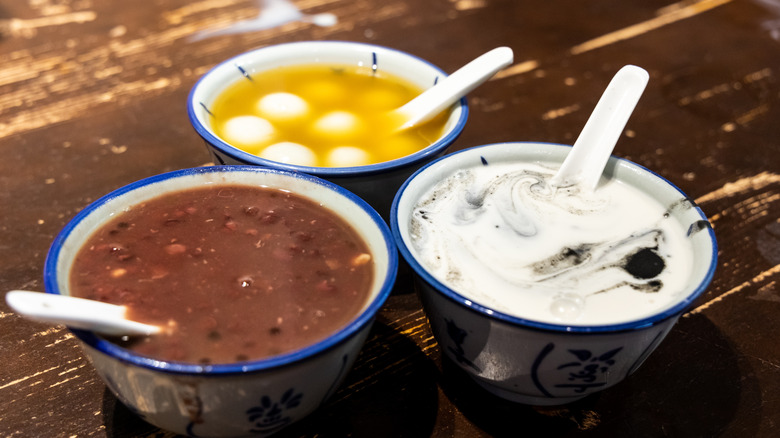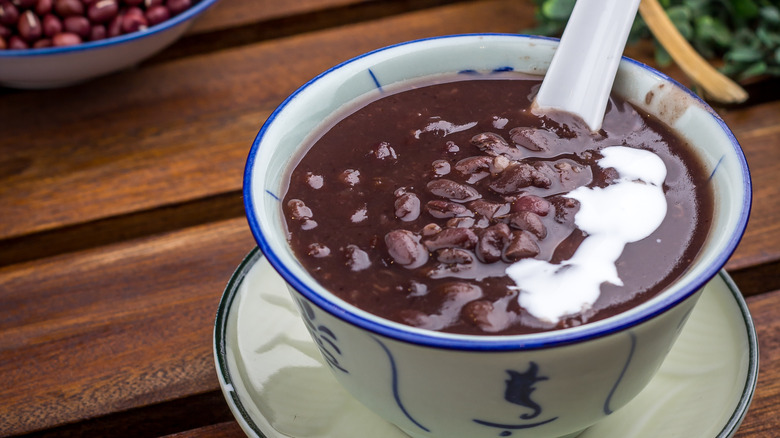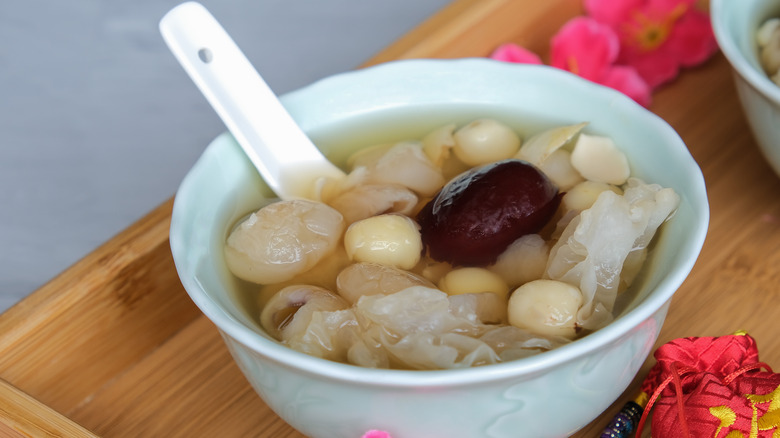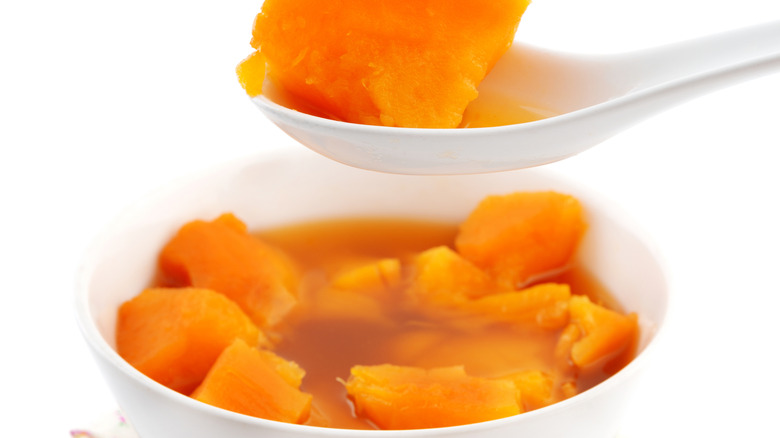Tong Sui: The Sweet Cantonese Treat You Should Know
As far as Chinese medicine is concerned, everything we eat affects our bodies in specific ways — and by that, we're not talking about the Western idea of consuming calories, fats, proteins, and carbs. Instead, foods are seen as cooling, warming, or balanced. Per Ping Ming Health, foods that are "cooling" can "clear heat and toxins, cool and calm the blood," as well as "nourish yin," while "warming" foods raise your energy levels and improve circulation as well as correct "yang deficiencies." Balanced foods are neither warming nor cooling; this is where sweet soup comes in.
While Western-style pastries served at the end of the meal aren't likely to fulfill any nutritional functions, that's not the case with tong sui or "sweet soups." Food Next says "sugar water" or "sweet soup" has a history that dates back hundreds of years, and it was consumed at the Imperial Court by ancient Chinese royals and nobles to help digestion. Sweet soup is said to have been particularly popular in cities clustered around the Pearl River Delta, like Guangdong, Hong Kong, and Macau, because traditional Chinese medicine dictates that sugar balances out the effects of living in a generally warm and humid environment. This explains why instead of fortune and almond cookies, you're likely to be served a bowl of sweet soup at the end of a proper meal, particularly if you've just had a southern Chinese or Cantonese banquet.
Beans are a popular ingredient used in tong sui
But as Ta Kung Pao warns, tong sui is not an arbitrary mix of ingredients boiled to make a sweet soup; instead, different foods are combined to create a combination that reflects the Chinese idea of balance and nourishment, with recipes that date back generations.
While younger Cantonese are more likely to enjoy a bowl tong sui made with "sai mai lo" or mini tapioca pearls swimming in sweetened coconut milk; or even a fruity mango soup with bits of pomelo and sago, per Taste Atlas, there will be those that fall back on traditional favorites. Ta Kung Pao says the sweet soup served at a meal considers seasonality. Some tang sui is better for coping with summer heat, while others are best served during the winter.
One perennial tong sui favorite is red bean soup, which is served with adzuki beans cooked in tangerine peel and sugar water. It is rich in protein and is believed to help combat bloating after a large meal, per Souper Diaries. Red bean soup is usually enjoyed in the winter.
Another favorite is green bean soup, which uses mung beans and can be cooked with seaweed; it is said to help the body not just cleanse itself of toxins, it also helps manage high blood pressure, per Foodaciously. Ta Kung Pao says this tong sui is best consumed during summer.
Nuts and seeds are often found in different types of tong sui
Traditional tong sui is often made with nuts like almonds and walnuts or seeds like black sesame, which have been ground into a paste and sweetened. An almond tong sui or almond 'tea' was once enjoyed by the imperial family and was used to keep skin glowing and supple. A thick, comforting bowl of walnut soup or hup tul woo benefits brain functions, and black sesame is rich in magnesium, calcium, and iron, per Mother Earth Living. "Zhi ma hu," or black sesame seed soup, is said to have many health benefits because it is rich in magnesium, calcium, manganese, and vitamin B, per Taste Atlas. It's even meant to help improve digestion and reduce blood fat, making it a perfect after-dinner sweetener.
Unlike other nuts, ginko nuts are cooked and served whole. These nuts are said to help keep the brain healthy and sharp — and they are a popular ingredient in traditional tong sui. Malay Mail refers to a recipe of snow fungus, red dates, and ginko nuts, which boosts collagen (snow fungus), and energy (red dates). Ginko nuts can also be used with tofu sheets to make a tong sui that's said to be good for your complexion, per Wok & Kin.
Papaya and sweet potato are popular ingredients for tong sui
We may not be used to seeing fruit cooked into a sweet soup, but that's exactly what happens to papaya when it's served as part of a tong sui. Papaya is cooked with snow fungus to deliver a dessert that helps with digestion and collagen production too. Nomss says this soup also helps lung function and boosts the immune system, making it the perfect tong sui to enjoy in the fall and winter months.
One of the simplest tong sui to make and enjoy is one made with sweet potato and ginger, cooked with a bit of brown sugar, per Wok & Kin. But if that might sound too plain, glutinous rice balls can be added in for a more substantial treat, too.
While traditional tong sui can be comfort food, it may not be everyone's cup of tea. As one Hong Kong tong sui maker tells the South China Morning Post, "It's a shame that young people are indifferent to traditional tong sui. Old-fashioned sweet soup stalls are not among their haunts, but we hope our contemporary twist to the traditional treats can help evoke their interest" — and these modern twists might include the use of coconut milk, condensed milk, as well as pearls made with taro, sweet potato, and purple potato.



